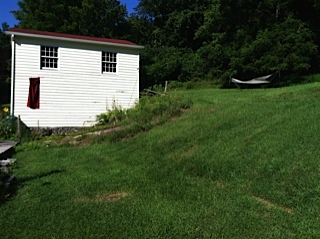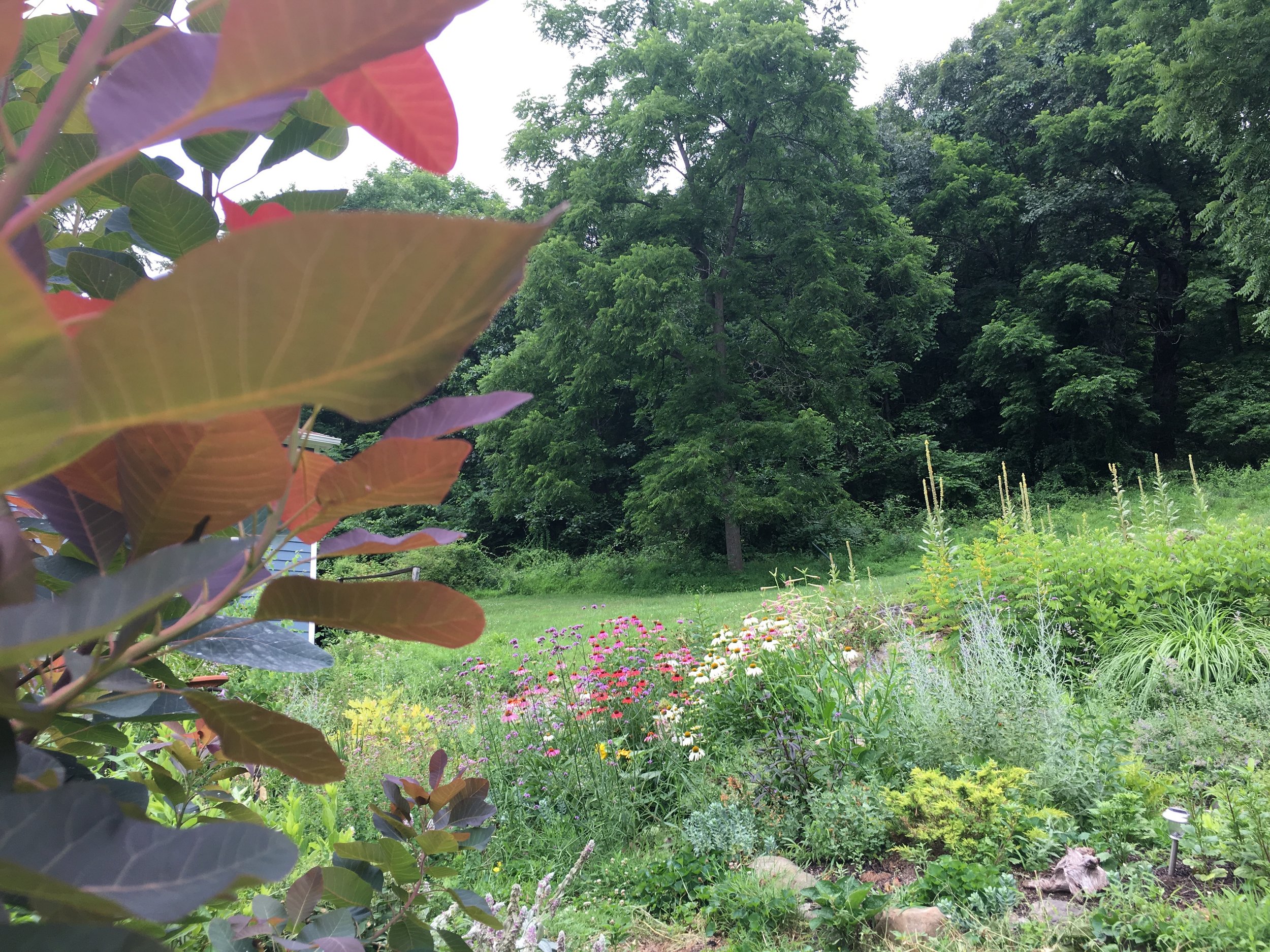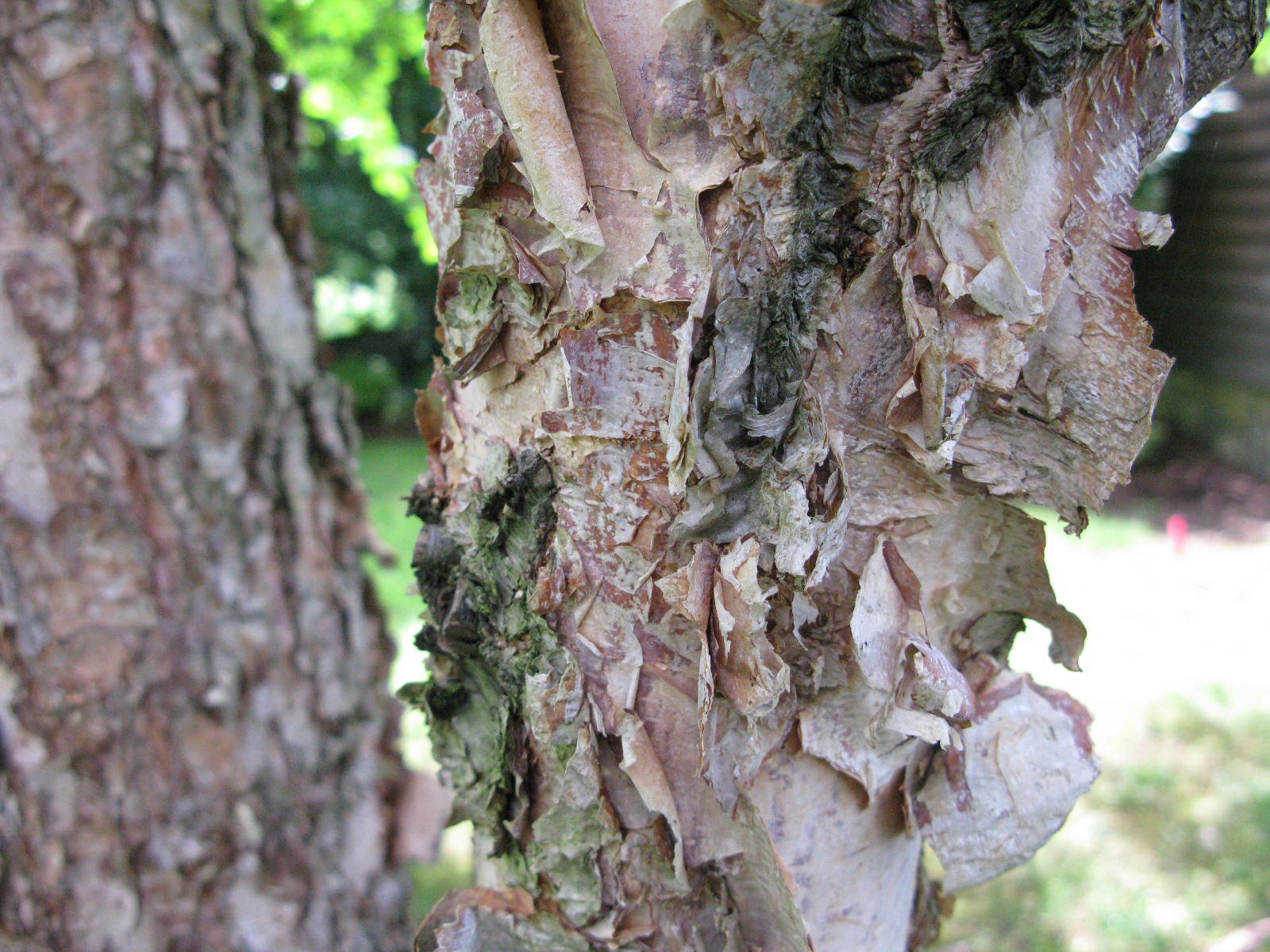Hellebores are here, and you won’t want to miss out on these varieties
/Hellebores are here and you don’t want to miss out.
Read MoreHellebores are here and you don’t want to miss out.
Read MoreIn this before and after the client had two issues. The first was that she wanted here backyard bursting with blooms. She is a plant lover and wanted us to create beds for a real "hort-head" collection garden.

The second issue, even though this bare grassy hillside looks innocent enough, every time it rained, water was pouring into the basement and compromising the foundation.
Creative garden design can fix both!
First we came in with an excavator and moved some of the dirt off the hillside. We wanted to create a path for water drainage AWAY from the house.

As we excavated, we happily unearthed some spectacular rock outcroppings and married them with a dry riverbed for drainage when it rained.

We transformed this boring and problematic hillside into an outdoor space that was full of character...and we hadn't even brought in plants yet!
Two years later, all the small perennials have filled out and the garden is a raucous explosion of blooms. This is honey bee heaven and you can hear the delightful buzz of healthy pollinators and watch the many Monarch butterflies flitting around in this beautiful garden.






That's one of the many butterflies flitting from bloom to bloom.

The exposed rock outcropping is now colonized with several varieties of sedum, adding yet another layer of color and texture to this once boring hillside!

At Victoria Gardens, every dramatic before and after begins with an hour long on-site consultation by Victoria. This visit allows the designer to see the space you envision becoming your garden and allows you an opportunity to express your desires and ideas and ask any questions you may have.
Design consultations are $150 and can be scheduled by calling the shop at (845) 658-9007.
Eastern Redbud (Cercis canadensis) ‘Hearts of Gold’ at Victoria Gardens in Rosendale, NY
The heart shaped leaves of this Redbud variety are a dazzling golden green. In the fall the leaves turn a striking orange/yellow. We love this tree planted at the woodland’s edge, where the striking light foliage stands out against the dark forest behind it.

Eastern Redbud (Cercis canadensis) Hearts of Gold at Victoria Gardens in Rosendale, NY

Eastern Redbud (Cercis canadensis) Heart of Gold at Victoria Gardens in Rosendale, NY

Eastern-Redbud-(Cercis-canadensis) at Victoria Gardens in Rosendale, NY
Eastern Redbud (Cercis canadensis)
Eastern Redbud Growing Zones: 4-9
Mature Height: 20-30 ft.
Mature Width: 25-35 ft.
Sunlight: Full or Partial
Soil Conditions: Very Adaptable, Black Walnut tolerant
Drought Tolerance: Medium
Blooms: small pink blooms on bare branches in the spring
Fall color: Golden yellow
A superb, underused plant with unique, early spring bloom. The vivid spring bloom cover the bare branches of mature trees, giving them a dramatic, velvety look.
But the real appeal of this understory tree are the heart shaped leaves. Available in deep purple, deep green and golden green, the eastern redbud adds character, texture and structure to a garden bed.



‘Heritage’ River Birch(Betula nigra ‘Heritage’)
‘Heritage’River Birch ‘Heritage’ Growing Zones: 4-9
Mature Height: 40-50 ft.
Mature Width: 25-30 ft.
Sunlight: Full or Partial
Soil Conditions: Very wet tolerant, clay tolerant
Bark: very ornamental in maturity
Fall color: yellow
As is implied in the name, river birch are well-suited for planting along river banks, and in other spots which can flood for weeks at a time, but they also thrive in normal soil conditions.
One of our best-selling trees!
Why we love it: This native tree is elegant and performs better in our area than its European cousin. Its bark is not quite as showy, but its form is lovely.
We love the ‘Heritage’ variety because of its glossier leaves, but it really shines in a winter garden too, because of its attractive silhouette and exfoliating reddish brown bark. The texture of the bark becomes more dramatic as the specimen matures. The dark outer bark peels, exposing salmon color underneath.
Betula nigra is fast growing, and the multi-branch, clumping river birch is graceful and elegant. We especially like the sophisticated look of the multi-trunk river birch planted in a grove.





Stewartia pseudocamllia (Japanese Stewartia)



Why we love it: The dramatic exfoliating bark and great fall foliage.
Hardiness Zones: 4 to 7
Height: 20 ft to 40 ft Spread: 20 ft to 40 ft
Form: pyramidal/oval in youth – more rounded in maturity
Type: deciduous tree
Annual Growth Rate: 6 to 12 inches
Flowers: White with yellow center Blooms in July
Prefers full sun, but will tolerate partial shade. Soil should be moist and ideally acidic. Dry soil will limit this trees growth. The real appeal of this tree is its stunning exfoliating bark. When branches reach 2″ or 3″ in diameter, the gray, gold, and brown pealing bark is a real stand-out as a winter interest. Plus the Stewartia has fantastic fall foliage.

Fagus sylvatica ‘Purple Fountain’ – purple weeping beech

Oxydendrum arboreum (Sourwood)
Why we love it: This native tree blooms when no other tree is blooming in summer, and with the panicles still on the tree, the fall foliage will knock your socks off.
Hardiness Zones: 5 to 9
Height: 25 ft to 30 ft Spread: 20 ft to 25 ft
Form: pyramidal
Type: deciduous tree
Annual Growth Rate: 8 to 15 inches
Flowers: White Blooms Mid- to Late Summer
Prefers full sun to partial shade. Can grow in acidic, infertile soil.. The primary attraction of this small deciduous tree is the drooping clusters of fragrant, white blossoms are borne on 4″ to 10″ long panicles. Flowers open over a three to four week period, and then the panicles remain on the tree while the leaves turn yellow, orange and red for a spectacular fall show. The persistent fruit remains on the tree through winter.
Syringa x ‘Boomerang’ – purple lilac tree (This matching pair is perfect for an entry way.)

Sciadopitys verticillata (Japanese Umbrella Pine)

Why we love it: Long glossy needles and slow to grow, this tree is like no other evergreen.
Hardiness Zones: 4 to 8
Height: 20 ft to 30 ft Spread: 15 ft to 20 ft
Form: pyramidal
Type: evergreen tree
Annual Growth Rate: 6 inches
Flowers: None
Prefers full sun to partial shade. Likes moist, acidic, well-drained soil. Slow growing tree, but worth the wait.
Long glossy needles give this tree a distinct look, different than any other evergreen.
Cutleaf Japanese Maple – 6′ to 10′ tall and wide – Zone 5 -A dwarf, mounded, small tree with a cascading and weeping habit. Also called a Threadleaf maple, the leaves are finely dissected (ribbon-like), and comes in many different varieties – too many to name! Visit the nursery in Rosendale, and fall in love with one! Full sun to part shade.



Q: Dear Victoria,
The deer seem to eat my annual containers like candy! Are there any annuals the deer will leave alone?
Help!
A: There are quite a few options for deer resistant annuals, then there are some varieties that they mostly leave alone, but nibble on occasionally, and there are, as you say, “deer candy.”
Everyone has different anecdotal evidence for one variety being left alone while another is always eaten, but after more than 3 decades as a professional landscaper in Ulster county – these are my findings:
Deer candy:
(You can plant these if you are deer free, protected by a fence or if you are willing to spray deer repellant. We carry Deer Defeat, an all natural, locally produced deer spray.)
Sweet potato vine
Coleus
Oxalis
Impatients
Fuchsias
Annuals that deer mostly leave alone:
Zinneas
Marigolds
Angelonia
Snapdragons
Cosmos
Fragrant petunias
Persian shield
Geraniums
Deer resistant:
Annual Grasses
Mint
Salvia
Agastache
Verbena bonariensis
Cleome
Lantana
Euphorbia “Diamond frost”
We have a huge selection of annuals in stock, so come in this weekend and pick out some all-summer color for your containers and gardens.
If you battle the deer, don’t worry we’ve got you covered!
And if you have questions about many of the other varieties we carry, just ask one of the knowledgeable gardeners who work in the store -they can help you find the right combination for your planter: sun, shade, deer-resitant, drought-tolerant – we have the perfect annuals for you.
Happy planting!
Dawn Redwood Metasequoia glyptostroboides ‘Gold Rush’
Dawn Redwood Growing Zones: 4-8
Mature Height: 40-50 ft.
Mature Width: 20-30 ft.
Sunlight: Full or Partial
Soil Conditions: Very Adaptable
Drought Tolerance: Good
Fall color: Orange and yellow
The Dawn Redwood tree, Metasequoia glyptostroboides, is a deciduous conifer, with soft needle-like leaves that look like evergreens, but are bright green in the spring and brilliant orange/red in the fall. The needles are then shed in winter.
Dawn Redwood trees are a very interesting–one of the few deciduous conifers in the world.
It is feathery pyramidal in form with a straight, fluted trunk. It grows very fast to 40’ and can grow to 70’. Dawn Redwoods are considered by many to be the Fastest Growing Conifer.

Dawn-Redwood-Metasequoia-glyptostroboides-‘Gold-Rush’ at Victoria Gardens in Rosendale, NY

Dawn Redwood Metasequoia glyptostroboides ‘Gold Rush’ at Victoria Gardens in Rosendale, NY

Growing herbs, especially in easily accessible pots near your grill or kitchen door is one of the true luxuries of summer. Grabbing a fist full of fresh oregano or thyme to throw into a dish in progress will make you happy! But there are some unusual edibles we’d like you to consider this summer:

Corsica mint is one of our favorites, because it is so so fragrant. When you pet the tiny, densely packed foliage, it releases a heavenly, minty fragrance. We recommend you plant a full pot of it near a lounge chair for relaxation and aromatherapy purposes, but it can also be planted in the ground as a steppable ground cover. Use it in iced tea or sprinkle the little leaves over fresh greens.
Another one of our favorites is French Sorrel. You need to harvest the leaves before the plant bolts (throws up its flowers) and you can harvest it multiple times through the season. The baby leaves add a lemony bite to fresh salads or a wonderful herb and aromatic to throw in with fish dishes, but French Sorrel soup is the best use of this leafy green!

Chocolate mint can be used to infuse milk for homemade ice cream, but chocolate mint mojitos are also a crowd pleaser. Mints have a tendency to take over in the garden, so they are the perfect herb to keep in a container.

Cold hardy, perennial herbs—like mint, sage and thyme—can overwinter in pots outside, but more tender herbs—like rosemary—need to be brought inside in the fall or planted a new each spring. Pots of herbs perform best in full sun, but no fertilizers are needed. Most herbs thrive in lean soil and like to dry out in between watering. That said, they can perform just fine in a mixed container if you want to throw an herb in with blooming annuals.







We also love the idea of an all edible mixed pot. Here are a few edible flowering plants to brighten up your grill side herb boxes: violets, pansies, and violas. The small, delicate flowers can be used to decorate desserts or garnish any main dish. Nasturtium is a prolific annual with red, yellow and orange blossoms. The flower and the foliage are both pretty and peppery. They make a spicy addition to salads or fish dishes. The thick, juicy petals of Tuberous Begonia taste like lemon water. They can be tossed into salads or drinks for a colorful, tart crunch. You don’t see these commonly used, maybe because most people feel the flowers are too beautiful to eat!
Victoria Gardens is located in Rosendale, NY on the corner of Rt 213 and Cottekill Road. We are a fully stocked plant nursery, garden center, and garden gift shop.
Throughout the season we have classes and special events, including private garden tours from March through November. October through December we carry holiday gifts, decor, handcrafted wreaths, and we feature a DIY Holiday Wreath Studio.
At Victoria Gardens during the gardening season, you will find a selection of trees, shrubs, and perennials that are chosen specifically for our area and for our customers most frequently voiced problems: deer, dry soil, wet spots, and shady areas.
Our knowledgeable staff will help you find the perfect combinations, so you only have to plant once!
March hours:
Friday, March 28th 9am-5pm
Saturday, March 29th 9am-5pm
Sunday, March 30th 10am-4pm
April hours:
Monday - Saturday 9am-5pm
Sunday 9am-4pm
(845) 658-9007
The shop is awash in greenery and stocked full of all the latest plants of interest; trendy foliage, succulents & cacti, petite fairy garden plants, lush ferns, pet- friendly plants, the best air purifiers — truly something for everyone. We promise that you’ll leave with a new plant friend to nurture for years to come.
The Victoria Gardens' landscaping crew are experienced and knowledgeable gardeners. Besides designing and installing new gardens, we also offer maintenance, spring cleanups, pruning, transplanting, weeding, and mulching.
Call to get an estimate: (845) 658-9007
If you are trying to find a special variety, call us and ask. We have a wide range of growers in our network and we can place special orders to meet your needs.
Victoria Coyne
+1 (845) 658-9007
victoriagardens.ny@gmail.com
Powered by Squarespace.